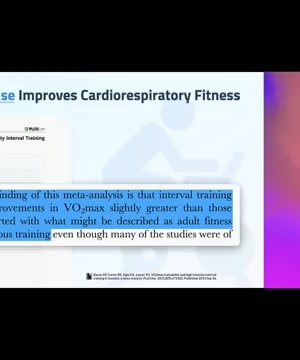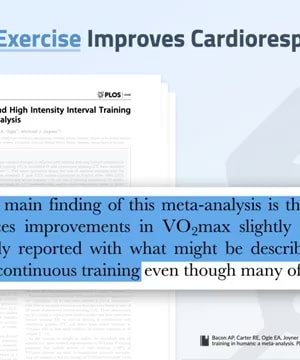What protocol is recommended for improving vo2 max
Sources:
Improving VO2 max involves targeted training protocols aimed at enhancing cardiovascular efficiency and oxygen utilization. Here are some expert-recommended methods:
-
Norwegian 4x4 Protocol: This is highly endorsed by experts like and . It involves four minutes of high-intensity exercise followed by three minutes of low-intensity recovery, repeated four times. The key is to maintain a high effort during the four-minute intervals, reaching around 75-80% of your max heart rate while being unable to talk during the effort 1 2.
-
High-Intensity Interval Training (HIIT): Shorter intervals, such as one-minute exercises followed by rest, have also proven effective. notes that these can be more manageable and still significantly improve VO2 max 3.
-
Modality Selection: Choose exercises that you are technically proficient in to avoid injuries and ensure maximum effort. Running, cycling, swimming, or using an assault bike are common choices. The key is consistency and maintaining high intensity without compromising form 4.
-
Mixed Methods: emphasizes combining different modalities and tailoring your training to address specific limitations, whether they are cardiovascular, muscular, or respiratory 5.
Overall, incorporating these high-effort, interval-based training protocols into your routine can effectively improve VO2 max and enhance cardiovascular fitness.
RELATED QUESTIONS-
Who are the top experts on VO2 max training?
Sources:
Here are some top experts on VO2 max training:
-
: A professor of kinesiology at California State University, Fullerton. He is known for his work on human performance, cardiorespiratory fitness, and VO2 max. He frequently shares his expertise through various podcasts, including the , , and The Tim Ferriss Show.
-
: An exercise physiologist and founder of Critical Oxygen, where he teaches athletes and coaches about physiological principles to enhance endurance performance. He has a PhD in human bioenergetics from Oregon State University.
-
: A hybrid athlete and coach specializing in Zone 2 cardio training. He is known for discussing the benefits of this training modality for health, fitness, and athletic performance on podcasts such as .
-
: An endurance sports coach and author of "The Triathlete’s Training Bible." He holds a master's degree in exercise science, is a USA Triathlon and USA Cycling certified elite-level coach, and has been featured on podcasts like Keeping It Real: Conversations with Jillian Michaels.
These experts provide a wealth of information on improving VO2 max through various training protocols and strategies.
RELATED QUESTIONS-
What does Andy Galpin say about VO2 max?
Sources:
provides extensive insights into VO2 max, emphasizing its critical importance and practical aspects of measurement and improvement.
-
Importance and Measurement: Galpin describes VO2 max as a significant predictor of lifespan, outperforming traditional health markers like blood pressure and cholesterol by three to six times. It measures the maximum amount of oxygen one can utilize, reflecting the health of the lungs, heart, and muscles. Regular testing (ideally once a year) provides valuable information for tailoring fitness programs and is considered a worthwhile investment 1.
-
Calculation and Interpretation: He explains VO2 max using the Fick Equation, which involves cardiac output (heart rate multiplied by stroke volume) and the arterial-venous oxygen difference (Avo2). This equation helps understand the efficiency of oxygen delivery and utilization by the body 2 3.
-
Training for Improvement: To improve VO2 max, Galpin emphasizes the importance of choosing the right exercise modality, ensuring technical proficiency to avoid injuries. He suggests using a combination of high-intensity intervals and endurance training tailored to individual capabilities and goals 4 5.
-
Practical Applications: He provides practical protocols and methodologies for improving VO2 max, highlighting that there isn't a one-size-fits-all approach. Instead, he underscores the necessity of identifying individual limitations (e.g., heart size, oxygen extraction efficiency) to customize training programs effectively 6 7.
Galpin's comprehensive approach to VO2 max training offers a scientific yet practical framework for enhancing cardiovascular fitness and overall health.
RELATED QUESTIONS-
How can I improve my VO2 max?
Sources:
offers detailed strategies for improving VO2 max, emphasizing both the type of exercise and the approach:
Key Strategies:
-
Specificity: Training on the same modality you test on (e.g., rower, bike, treadmill) enhances VO2 max more effectively due to improved efficiency in motor patterns 1.
-
Program: There's an eight-week training program designed for various fitness levels, starting conservatively and progressively increasing intensity. Detailed parameters are available in the show notes of his episodes 1.
-
Types of Training:
- Lower Intensity, Longer Duration: Aim for continuous exercise (e.g., running, cycling, swimming) that keeps your heart rate elevated for 20-60 minutes. This method develops cardiovascular endurance 2.
- High-Intensity, Shorter Duration: Incorporate high-intensity interval training (HIIT), like 30 seconds as hard as you can, followed by 30 seconds of rest, for several rounds. This pushes your heart rate closer to its maximum capacity 2.
-
Interval Training: HIIT, especially the Norwegian 4x4 protocol (four minutes at max intensity followed by three minutes of light activity, repeated four times), is highly effective 3.
-
Measuring Progress: Regular testing (annual) in a controlled setting, like using a power meter on a bike, can help track improvements and maintain motivation 4.
Physiological Insights:
- Cardiac Output: The heart's strength and the volume of blood pumped per beat are crucial 5.
- Capillary Density: Increased capillaries in muscles slow blood flow, enhancing oxygen extraction 6.
- Mitochondria: More mitochondria in muscle cells improve the use of oxygen for energy production 6.
Overall, underscores the importance of varying exercise intensity and methodically progressing workouts to effectively boost VO2 max. Adaptations depend on consistently challenging the cardiovascular system and tailoring the approach to individual fitness levels.
RELATED QUESTIONS-
Give me a protocol for vo2 max
Sources:
To improve your VO2 max, you can follow the well-regarded Norwegian 4x4 protocol, as discussed by on the podcast:
Norwegian 4x4 Protocol:
- Warm-Up: Ensure you are properly warmed up before starting the intervals.
- High-Intensity Intervals: Perform 4 minutes of high-intensity exercise at 75-80% of your maximum heart rate. This should be intense enough that you can't talk comfortably but not so intense that you can't sustain it for the full 4 minutes.
- Recovery Periods: Follow each high-intensity interval with 3 minutes of low-intensity recovery. During this phase, bring your heart rate down to around Zone 1 (very light effort).
- Repetitions: Repeat the high-intensity and recovery phases for a total of 4 cycles (hence the name 4x4).
This protocol is highly effective in improving VO2 max and is supported by substantial research 1 2.
Additionally, for those looking for a different or supplementary approach, also mentions that even shorter 1-minute high-intensity intervals, repeated multiple times, can effectively boost VO2 max 3. Integrating high-intensity interval training (HIIT) into your routine can yield significant improvements, particularly if initial moderate-intensity aerobic exercises fail to elicit desired changes in VO2 max 4.
RELATED QUESTIONSList clips similar to "Cardio Fitness Insights"
Sources:
Here are some clips similar to "Cardio Fitness Insights," offering expert advice and practical tips on improving cardiorespiratory fitness:
-
Enhancing Fitness Tools: discusses tools to improve fitness, including breathing, nutrition, and specific training recommendations.
-
Boosting VO2 Max: highlights the importance of incorporating high-intensity interval training, mentioning effective protocols like the Norwegian 4x4.
-
Aging and Exercise: explores how interval training can help maintain both cardiorespiratory fitness and muscle strength as we age.
-
Optimal Fitness Tools: shares effective fitness protocols and tools to enhance cardiovascular and strength training.
-
Cardio Fitness Insights by Andy Galpin: emphasizes the importance of improving VO2 max for health and longevity.
-
Cardio Fitness Insights by Rhonda Patrick: elaborates on how high-intensity interval training can improve VO2 max and cardiorespiratory fitness.
-
Zone Two Training: discusses the benefits of Zone Two training for cardiorespiratory fitness and longevity.
These clips provide a range of insights and methods to enhance cardiorespiratory fitness based on scientific evidence and expert recommendations.
RELATED QUESTIONS-
What is Huberman protocol for improving vo2 max
Sources:
Here is the protocol recommended by for improving VO2 max:
-
12-Minute Cooper's Test:
- Run as far as possible in 12 minutes.
- Record the distance covered and use online calculators to estimate your VO2 max based on this distance 1.
-
Cardio Training Structure:
-
Interval Training:
- Alternate between high-intensity work and rest periods.
- This can encompass sprint intervals of 20-30 seconds, followed by a longer rest period (e.g., 1-2 minutes) 4.
-
Additional Tests:
- A 1-mile walk test can alternatively be used, where you walk a mile, record the time and your heart rate at the end to estimate VO2 max 1.
Combining these elements can provide a robust protocol for improving VO2 max and overall cardiovascular fitness.
RELATED QUESTIONS-
If I want to do one exercise, what is the best to improve VO2 max
Sources:
According to experts, incorporating high-intensity interval training (HIIT) is highly effective for improving VO2 max. Specifically, the Norwegian 4x4 protocol is repeatedly highlighted as one of the best methods. This involves:
-
Four Minutes of Intense Exercise:
- Perform at the highest intensity you can maintain for the entire four minutes.
- Aim for 80% of your maximal heart rate to ensure you’re pushing hard but not going all-out initially 1.
-
Three Minutes of Recovery:
- Follow the intense bout with three minutes of light activity or complete rest. This helps in recovering enough to repeat the high-intensity effort.
-
Repeat Four Times:
This protocol has been shown to significantly boost cardiorespiratory fitness and VO2 max effectively across different fitness levels.
RELATED QUESTIONS-
Thankful practice benefit
Sources:
Practicing gratitude offers numerous benefits for both mental and physical health. Here are some key advantages highlighted by experts:
-
Reduced Stress and Depression:
- Keeping a gratitude diary for two weeks can reduce perceived stress by 28% and improve depression symptoms by 16%. Health practitioners practicing gratitude report 23% lower cortisol levels, indicating less stress 1.
-
Enhanced Mental Health:
- Gratitude practices can increase happiness, meaning, and joy. They can also build resilience against trauma and improve social relationships broadly, not just with the person you thank 2.
-
Physical Health Benefits:
-
Emotional Well-being:
-
Improved Relationships and Social Interactions:
- Expressing gratitude enhances social connections, making people more appreciative and supportive in their relationships 2.
A simple gratitude exercise like writing down three good things each day or writing a letter of gratitude can significantly boost these benefits over time 2 2.
RELATED QUESTIONS-
Gratitude practice benefit
Sources:
Practicing gratitude offers numerous benefits for both mental and physical health. Experts highlight several advantages:
-
Mental Health and Well-being:
- Regular gratitude practice can enhance feelings of happiness, meaning, and joy. It boosts resilience to trauma, helping reframe past traumatic experiences and providing inoculation against future stressors 1.
- Keeping a gratitude diary for two weeks showed a 28% reduction in perceived stress and a 16% improvement in depression symptoms 2.
-
Physical Health Improvements:
-
Neurotransmitter Benefits:
- Feeling grateful activates brain regions that produce dopamine and serotonin, which improves mood and promotes overall emotional well-being 3.
-
Social and Relational Benefits:
- Gratitude enhances social relationships, not just with the person being thanked but broadly across all interactions, including workplace, school, family, and romantic relationships 1.
-
Overall Life Satisfaction:
- Research indicates that keeping a gratitude journal can significantly increase well-being and life satisfaction by changing the way people perceive situations, leading to more positive focus and less stress 4.
Integrating simple gratitude practices, such as journaling or writing letters of thanks, can profoundly impact your life, fostering both immediate and long-term benefits 2 1.
RELATED QUESTIONS-




















